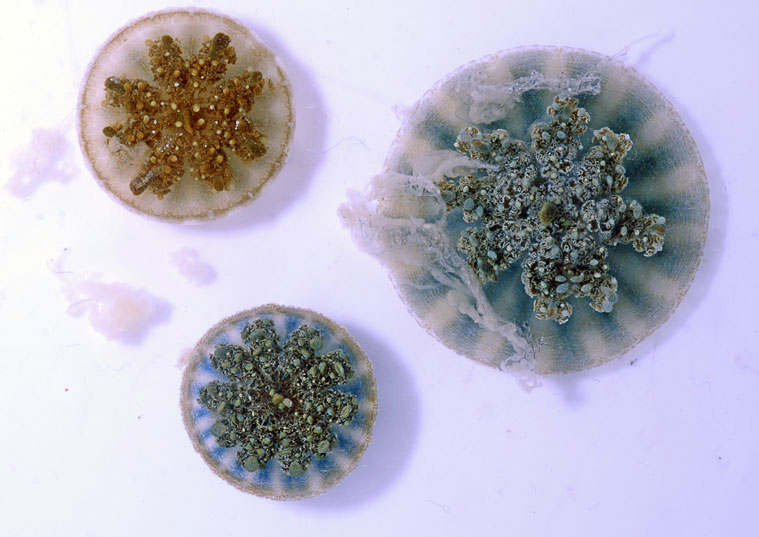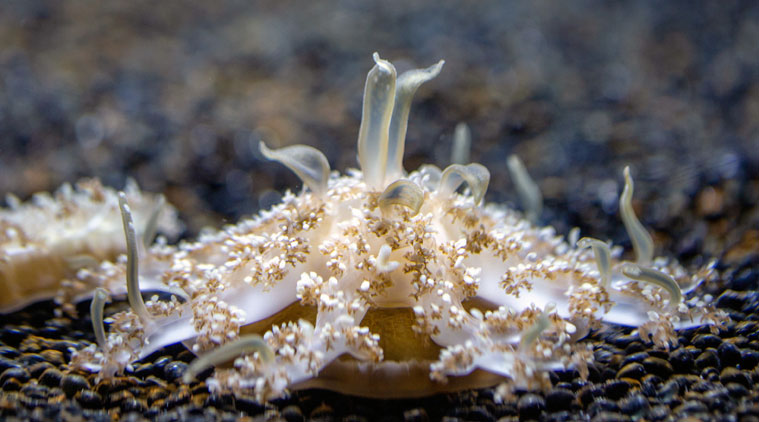You didn’t touch these Jellyfish, but they can sting you with tiny grenades
by New York TimesBy: New York Times | Published: February 14, 2020 4:51:13 pm

An undated photo provided by Allen Collins and Cheryl Ames shows upside-down jellyfish. The cloudy matter floating above and to the left of the jellyfish is a mucus that they exude that cause swimmers and prey to be stung without coming into contact with these jellyfish. (Allen Collins and Cheryl Ames via The New York Times)
By Cara Giaimo
Jellyfish are very sneaky about stinging. Most are silent. Some have venom that kicks in on a time delay. Many species even manage to get in a few zingers after they’re dead.
But according to research published Thursday in Communications Biology, the stealthiest stinging strategy belongs to Cassiopea xamachana, a species of upside-down jellyfish found in the Caribbean Sea, the Gulf of Mexico and warm parts of the Western Atlantic like the Florida Keys. When disturbed, this creature acts like a space-movie mother ship — it emits tiny balls of stinging cells that then swim around on their own, zapping anything in their path.
These “self-propelling microscopic grenades,” which the researchers have named cassiosomes, also appear to stun and kill prey for the jellyfish, said Cheryl Ames, an associate professor at Tohoku University in Japan and lead author of the study.
The finding is “paradigm-shifting” and will change how researchers think about how jellyfish eat and sting, said Angel Yanagihara, a jellyfish envenomation expert at the University of Hawaii who was not involved with the study.
Upside-down jellyfish don’t seem threatening. They move very little and spend most of their time on the ocean floor, nestled in sea grass or the roots of mangrove forests. Thanks to a symbiotic relationship with marine algae, most of them are soft shades of pink, blue, brown or green. And as their name suggests, they orient themselves differently than other jellies, resting on their gelatinous heads while their frilly arms stretch upward. “They’re beautiful,” Ames said.
But looks can be deceiving. Ames, who usually studies deadly box jellyfish, always covers up completely for dives. Even so, she noticed that when she and her colleagues admired the upside-down jellies, they often came out of the water covered in “itchy and irritating” stings, she said.

A photo provided by the National Aquarium in Baltimore shows an upside-down jellyfish. The creature is mostly stationary, so it evolved self-propelling cells that can swim over and sting you on its behalf. (National Aquarium via The New York Times)
Others were experiencing the same phenomenon even when they were “just handling the water” of an aquarium that these jellyfish had been in, she said. One aquarist told her he had repeatedly replaced the heater in an upside-down jellyfish tank, assuming a faulty wire was shocking him.
The US Navy has long been curious about difficult-to-source jellyfish stings, said Gary Vora, the deputy laboratory head within the Center for Bio/Molecular Science and Engineering at the Naval Research Laboratory in Washington, DC , and another author of the paper. Navy divers will sometimes get in what looks like clear water and end up “lit up like a Christmas tree,” he said. “You have evidence of a sting, but you never saw what stung you.”
Ames, Vora and their colleagues took a closer look. Because upside-down jellyfish can’t move, they release clouds of mucus that trap prey.
When the researchers put this mucus under a microscope, they found it was studded with “self-propelling, jelly-filled packages of stinging cells,” Ames said.
In most jellyfish, stinging cells are part of the tentacles. But these packages were swimming on their own, propelled by waving hairs called cilia. They looked like “pieces of popcorn that were moving around,” Ames said.
The researchers named the strange clusters cassiosomes. Through more lab experiments, they found that cassiosomes are formed in small pads on the upside-down jellyfish’s arms. Hundreds of thousands of them, at least, are released at a time. They can sting a brine shrimp to death on contact — leaving it in the mucus for the jellyfish to suck back up. And in the lab, the sting packs survived on their own for up to 10 days.
Each cassiosome also contains a bit of the same symbiotic algae that lives within the main body of the jellyfish, although researchers don’t yet know why.
The researchers also discovered similar cassiosomes in four related jellyfish species. If this turns out to be a popular strategy, that might explain other mysteries, such as why salmon in aquaculture pens are sickened and sometimes die during jellyfish blooms without ever coming into direct contact with the jellyfish, said Yanagihara.
Vora hopes to figure that out quickly — while the upside-down jelly is a nuisance at worst, a ranged attack from a stronger stinger would be no joke.
“We’re very interested in who else does this,” he said. “There are other jellyfish we’re much more worried about.”
📣 The Indian Express is now on Telegram. Click here to join our channel (@indianexpress) and stay updated with the latest headlines
For all the latest Technology News, download Indian Express App.
- Tags:
- Jellyfish